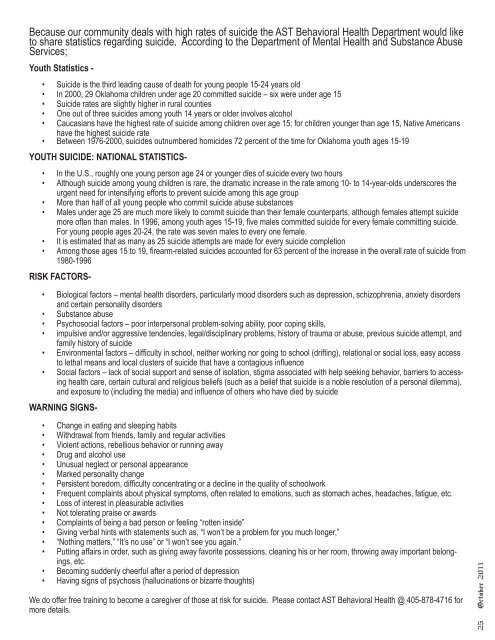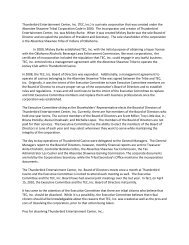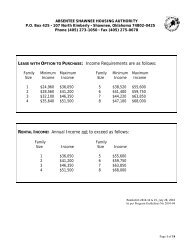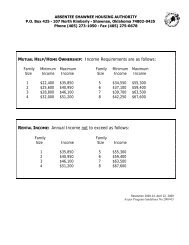October 2011 - Absentee Shawnee Tribe Of Oklahoma
October 2011 - Absentee Shawnee Tribe Of Oklahoma
October 2011 - Absentee Shawnee Tribe Of Oklahoma
Create successful ePaper yourself
Turn your PDF publications into a flip-book with our unique Google optimized e-Paper software.
Because our community deals with high rates of suicide the AST Behavioral Health Department would like<br />
to share statistics regarding suicide. According to the Department of Mental Health and Substance Abuse<br />
Services;<br />
Youth Statistics -<br />
• Suicide is the third leading cause of death for young people 15-24 years old<br />
• In 2000, 29 <strong>Oklahoma</strong> children under age 20 committed suicide – six were under age 15<br />
• Suicide rates are slightly higher in rural counties<br />
• One out of three suicides among youth 14 years or older involves alcohol<br />
• Caucasians have the highest rate of suicide among children over age 15; for children younger than age 15, Native Americans<br />
have the highest suicide rate<br />
• Between 1976-2000, suicides outnumbered homicides 72 percent of the time for <strong>Oklahoma</strong> youth ages 15-19<br />
YOUTH SUICIDE: NATIONAL STATISTICS-<br />
• In the U.S., roughly one young person age 24 or younger dies of suicide every two hours<br />
• Although suicide among young children is rare, the dramatic increase in the rate among 10- to 14-year-olds underscores the<br />
urgent need for intensifying efforts to prevent suicide among this age group<br />
• More than half of all young people who commit suicide abuse substances<br />
• Males under age 25 are much more likely to commit suicide than their female counterparts, although females attempt suicide<br />
more often than males. In 1996, among youth ages 15-19, five males committed suicide for every female committing suicide.<br />
For young people ages 20-24, the rate was seven males to every one female.<br />
• It is estimated that as many as 25 suicide attempts are made for every suicide completion<br />
• Among those ages 15 to 19, firearm-related suicides accounted for 63 percent of the increase in the overall rate of suicide from<br />
1980-1996<br />
RISK FACTORS-<br />
• Biological factors – mental health disorders, particularly mood disorders such as depression, schizophrenia, anxiety disorders<br />
and certain personality disorders<br />
• Substance abuse<br />
• Psychosocial factors – poor interpersonal problem-solving ability, poor coping skills,<br />
• impulsive and/or aggressive tendencies, legal/disciplinary problems, history of trauma or abuse, previous suicide attempt, and<br />
family history of suicide<br />
• Environmental factors – difficulty in school, neither working nor going to school (drifting), relational or social loss, easy access<br />
to lethal means and local clusters of suicide that have a contagious influence<br />
• Social factors – lack of social support and sense of isolation, stigma associated with help seeking behavior, barriers to accessing<br />
health care, certain cultural and religious beliefs (such as a belief that suicide is a noble resolution of a personal dilemma),<br />
and exposure to (including the media) and influence of others who have died by suicide<br />
WARNING SIGNS-<br />
• Change in eating and sleeping habits<br />
• Withdrawal from friends, family and regular activities<br />
• Violent actions, rebellious behavior or running away<br />
• Drug and alcohol use<br />
• Unusual neglect or personal appearance<br />
• Marked personality change<br />
• Persistent boredom, difficulty concentrating or a decline in the quality of schoolwork<br />
• Frequent complaints about physical symptoms, often related to emotions, such as stomach aches, headaches, fatigue, etc.<br />
• Loss of interest in pleasurable activities<br />
• Not tolerating praise or awards<br />
• Complaints of being a bad person or feeling “rotten inside”<br />
• Giving verbal hints with statements such as, “I won’t be a problem for you much longer,”<br />
• “Nothing matters,” “It’s no use” or “I won’t see you again.”<br />
• Putting affairs in order, such as giving away favorite possessions, cleaning his or her room, throwing away important belongings,<br />
etc.<br />
• Becoming suddenly cheerful after a period of depression<br />
• Having signs of psychosis (hallucinations or bizarre thoughts)<br />
We do offer free training to become a caregiver of those at risk for suicide. Please contact AST Behavioral Health @ 405-878-4716 for<br />
more details.<br />
25 <strong>October</strong> <strong>2011</strong>















